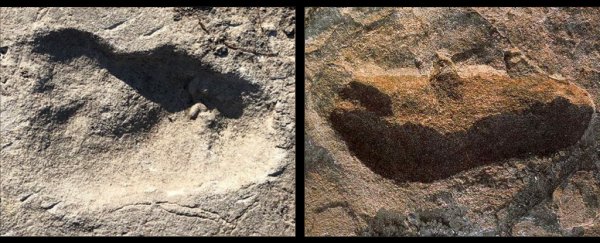A staggering 3.7 million years ago, an unknown species walked on two legs across a blanket of volcanic ash in what's now northern Tanzania. These steps, immortalized by the volcanic ash gradually turning into rock, were unearthed back in 1978 and mistakenly dismissed as being bear-like.
But not everyone agreed.
"Reliable identification of these enigmatic prints at Laetoli Site A will be impossible until they are more fully cleaned and followed laterally," University of California anthropologists Tim White and Gen Suwa argued in 1987.
Over forty years after the discovery, Ohio University anthropologist Ellison McNutt and colleagues have done just that, and compared the five consecutive footprints to the locomotion of bears (Ursus americanus), chimpanzees (Pan troglodytes), and humans.
Their analysis suggests the prints were from an unknown species of bipedal primate that clearly differed from the tracks left by another hominin species left nearby.
The Laetoli trackway featured an amazing 18,400 impressions of animal steps, including prints from hyenas, giraffes and ostriches, and hominins that walked in a similar way we do.
While assigning footprints to skeletons and species is a tricky business, researchers are now fairly confident those footprints at Site G and S belonged to Australopithecus afarensis – the same species as the famous Lucy. The prints attributed to A. afarensis suggest hominids that stood between 111 to 168 centimeters (3.7 - 3.8 ft) tall.
The mystery tracks from Site A come from a smaller individual, closer to 100 cm in height. This could mean the prints were made by a youngster, but McNutt and team believe that morphological differences indicate otherwise.
The overall size of the footprints was bearlike, with an unusually wide but short foot. The mystery species imprinted a clear big toe, with a similarly lengthened second toe and a wide heel. Chimpanzees and bears have comparatively narrow heels. Bears also tend to take steps with feet far wider apart, and there were no signs of claw marks.
The bipedal prints at Site A portrayed a strange movement that involved each foot crossing side to side, and being placed on the ground heel-to-toe. This resulted in a left footprint that was further to the right than the right footprint, and vice versa.
Of course, the unusual gait could have also been caused by an individual spontaneously walking abnormally at that key point on their travels, such as after nearly falling over. Perhaps the terrain was a factor; but from skipping to tiptoeing, humans aren't exactly known for always moving about in the same manner either, particularly when we're young.
The big toe imprint juts out to the side more than would be formed by our own feet, but not quite as much as in a chimpanzee's foot – a possible sign of branch gripping toes. There is also a hint of a raised ridge that may indicate midfoot mobility – another useful tree-climbing trait.
In an accompanying commentary published with the new analysis, Max Planck Institute paleoanthropologist Stephanie Melillo points out the 'Burtele' foot fossils from Ethiopia also displayed similar grasping foot traits, like an opposable toe.
But this species' big toe is clearly bigger than its second toe; how much variance in this exists between individuals of this mystery species is not known.
In the 1970s, A. afarensis was the earliest known human relative, so researchers thought they were our direct ancestor; new fossil finds since have shown things were a lot more complicated, with multiple hominin species coexisting during the same timeframe. This new research further adds to this nuanced mosaic.
Taken together, McNutt and team conclude that there's growing evidence multiple hominin species used a variety of foot shapes to wander Africa during this period of our truly ancient history.
Their research was published in Nature.
